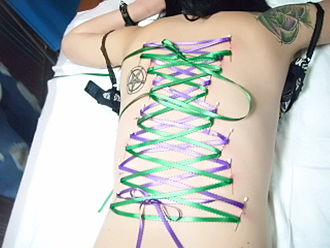Corset piercing
Corset piercing is a form of body modification where piercings are made on the body and laced together resembling the appearance of a corset. Typically, corset piercings are found on the back, but they can also be placed on the side of the body, the stomach, and even the neck or legs. This type of piercing is more decorative than functional, serving as a temporary adornment due to the high risk of rejection and migration by the body.
Procedure
The process of getting a corset piercing begins with the selection of the area to be pierced. After cleaning and marking the spots, a professional piercer uses a hollow needle to create the piercings, usually inserting body jewelry such as barbells or rings. Once the piercings have healed sufficiently, they can be laced with ribbons or cords to create the corset effect. The number of piercings can vary, but they are typically done in pairs to allow for symmetrical lacing.
Risks and Considerations
Corset piercings, like all forms of body modification, come with risks. The primary concerns include infection, rejection, and migration of the piercings. Due to the surface nature of these piercings, they are prone to snagging on clothing and other objects, which can lead to irritation and increased risk of complications. Proper aftercare is crucial to minimize these risks, including regular cleaning and monitoring for signs of infection.
Another consideration is the temporary nature of corset piercings. Unlike traditional piercings that can last a lifetime with proper care, corset piercings are often not permanent. The body's natural healing process can lead to the closure of these piercings if they are not maintained with jewelry, and even then, many individuals find that they cannot keep corset piercings for extended periods due to the complications mentioned above.
Cultural Significance
Corset piercings draw inspiration from the historical use of corsets to shape the body and the aesthetic they provide. In modern times, they are a form of self-expression and body art, often associated with the body modification community. They can symbolize various meanings for the wearer, from a personal statement of beauty to an expression of control over one's body.
Conclusion
While corset piercings offer a unique and striking form of body art, they require careful consideration due to the associated risks and maintenance involved. Individuals interested in this type of piercing should seek out experienced professionals and be prepared for the aftercare and potential temporary nature of the adornment.
| This article is a stub. You can help WikiMD by registering to expand it. |
Transform your life with W8MD's budget GLP-1 injections from $125.
W8MD offers a medical weight loss program to lose weight in Philadelphia. Our physician-supervised medical weight loss provides:
- Most insurances accepted or discounted self-pay rates. We will obtain insurance prior authorizations if needed.
- Generic GLP1 weight loss injections from $125 for the starting dose.
- Also offer prescription weight loss medications including Phentermine, Qsymia, Diethylpropion, Contrave etc.
NYC weight loss doctor appointments
Start your NYC weight loss journey today at our NYC medical weight loss and Philadelphia medical weight loss clinics.
- Call 718-946-5500 to lose weight in NYC or for medical weight loss in Philadelphia 215-676-2334.
- Tags:NYC medical weight loss, Philadelphia lose weight Zepbound NYC, Budget GLP1 weight loss injections, Wegovy Philadelphia, Wegovy NYC, Philadelphia medical weight loss, Brookly weight loss and Wegovy NYC
|
WikiMD's Wellness Encyclopedia |
| Let Food Be Thy Medicine Medicine Thy Food - Hippocrates |
Medical Disclaimer: WikiMD is not a substitute for professional medical advice. The information on WikiMD is provided as an information resource only, may be incorrect, outdated or misleading, and is not to be used or relied on for any diagnostic or treatment purposes. Please consult your health care provider before making any healthcare decisions or for guidance about a specific medical condition. WikiMD expressly disclaims responsibility, and shall have no liability, for any damages, loss, injury, or liability whatsoever suffered as a result of your reliance on the information contained in this site. By visiting this site you agree to the foregoing terms and conditions, which may from time to time be changed or supplemented by WikiMD. If you do not agree to the foregoing terms and conditions, you should not enter or use this site. See full disclaimer.
Credits:Most images are courtesy of Wikimedia commons, and templates, categories Wikipedia, licensed under CC BY SA or similar.
Translate this page: - East Asian
中文,
日本,
한국어,
South Asian
हिन्दी,
தமிழ்,
తెలుగు,
Urdu,
ಕನ್ನಡ,
Southeast Asian
Indonesian,
Vietnamese,
Thai,
မြန်မာဘာသာ,
বাংলা
European
español,
Deutsch,
français,
Greek,
português do Brasil,
polski,
română,
русский,
Nederlands,
norsk,
svenska,
suomi,
Italian
Middle Eastern & African
عربى,
Turkish,
Persian,
Hebrew,
Afrikaans,
isiZulu,
Kiswahili,
Other
Bulgarian,
Hungarian,
Czech,
Swedish,
മലയാളം,
मराठी,
ਪੰਜਾਬੀ,
ગુજરાતી,
Portuguese,
Ukrainian
Contributors: Prab R. Tumpati, MD

